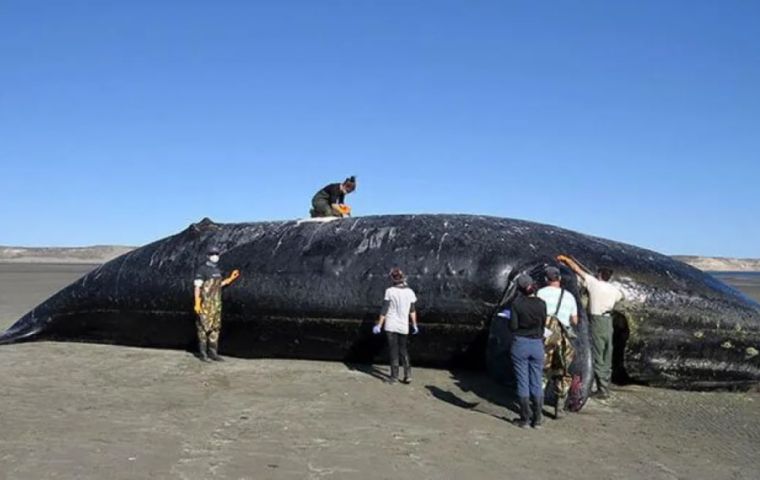MercoPress. South Atlantic News Agency
Argentine scientists studying death of Southern right whales on the Patagonia coast
 A Southern right whale corpse on a beach near Peninsula Valdes
A Southern right whale corpse on a beach near Peninsula Valdes Members of Argentina's INIDEP, the Fisheries Research and Development Institute, are working in Puerto Madryn to determine the cause of the sudden increase in the death of the Southern right whale, with dead corpses along the coast of the Valdes Peninsula, a mating and rest place for the migrating cetaceans.
A special team from INIDEP's Marine Chemistry and Toxic Tides Program has been taking tissue samples from dead whales and from other members of the Eubalaena species to analyze and assess the significance and origin of mollusk paralyzing toxins, better known as 'red tide, which have been detected in the area's waters.
The INIDEP team is working with the support of other marine related organizations from the Patagonian province of Chubut, such as the San Juan Bosco National University, plus scientists from Conicet, Argentina's Scientific and Technical Research Council at the Patagonian National Center.
According to the first reports from INIDEP researchers, whales mortality is associated to bio-toxins, originated in the blooming of noxious algae, with a concentration of paralyzing toxins particularly in mussels.
“They are possibly originated in the blooming of toxic algae belonging to the Alexandrium catenella species”, according to the heads of the INIDEP team, Dr Nora Montoya and Dr Marcela Uhart.
The involvement of the INIDEP team, according to a report from the institute, is essential since the screening of tissues and algae employ the HPLC method, which is defined as a liquid chromatographic of high resolution process. This technique allows to identify and quantify the toxins, and is the only lab capable of such processing in Argentina.




Top Comments
Disclaimer & comment rulesCommenting for this story is now closed.
If you have a Facebook account, become a fan and comment on our Facebook Page!